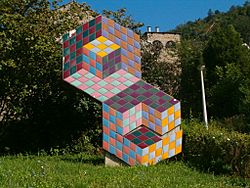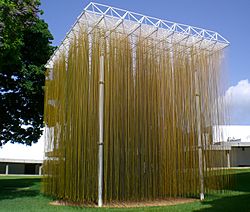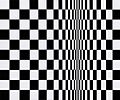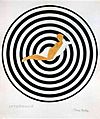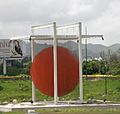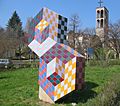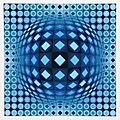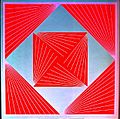Op art facts for kids
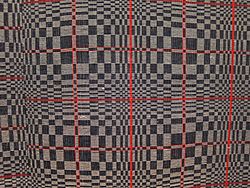
Op art is a cool style of art that plays tricks on your eyes! It uses optical illusions and other neat visual effects. Think of it like magic for your vision. This art often uses shapes, lines, and colors in ways that make them seem to move, flash, or even vibrate.
One of the first artists to really explore Op art was Victor Vasarely. He was from Hungary and started using these ideas in the 1930s. Later, in the 1960s, Op art became super popular.
Contents
What is Op Art?
Op art is short for "optical art." It's a type of abstract art, meaning it doesn't show real-world objects. Instead, it focuses on shapes, colors, and patterns. The main goal is to create an illusion of movement or depth on a flat surface.
How Op Art Tricks Your Eyes
Op art artists use different techniques to create these illusions:
- They often use black and white or very bright, contrasting colors.
- They repeat patterns and lines in a specific way.
- They might use perspective to make things look closer or farther away.
- Sometimes, the art seems to move or change as you look at it from different angles.
Famous Op Art Artists
Many artists have created amazing Op art pieces. Here are a few of the most well-known:
Bridget Riley: Master of Lines
Bridget Riley is a British artist who became very famous for her Op art in the 1960s. She is known for her detailed work with closely fitted lines. Her paintings often create a sense of movement or vibration just by using simple lines and curves. It's like the lines are dancing on the canvas!
Jesús Rafael Soto: Art That Moves
Jesús Rafael Soto was an artist from Venezuela. He took Op art a step further by adding moving parts to his artwork. This connected Op art with "kinetic art," which means art that actually moves. His pieces might have hanging rods or strings that sway, creating new optical effects as they move.
Victor Vasarely: The Pioneer
As mentioned, Victor Vasarely was one of the first to truly explore optical effects in his art. He used geometric shapes and bold colors to create illusions of depth and movement. His work often looks like it's popping out at you or swirling around.
M.C. Escher: Impossible Worlds
While not strictly an Op artist, the famous Dutch artist M. C. Escher also loved visual illusions. He drew amazing "impossible structures." These drawings look real at first, but if you look closely, you'll see they couldn't exist in the real world. He played with perspective and tricking the eye.
Why Do We See Illusions?
The idea of visual illusions has always fascinated people. Not just artists, but also scientists!
The Science Behind the Art
A famous art historian named Ernst Gombrich studied how visual effects work in art. He wrote a lot about how our brains interpret what we see. A psychologist named Richard Gregory spent much of his career studying why our minds see illusions. They found that our brains try to make sense of what our eyes see. Sometimes, when the visual information is tricky, our brains create an illusion!
Images for kids
-
Movement in Squares, by Bridget Riley 1961
-
Francis Picabia, c. 1921–22, Optophone I, encre, aquarelle et mine de plomb sur papier, 72 × 60 cm. Reproduced in Galeries Dalmau, Picabia, exhibition catalogue, Barcelona, November 18 – December 8, 1922.
-
Jesús Soto, Caracas
-
An optical illusion by the Hungarian-born artist Victor Vasarely in Pécs
-
Victor Vasarely, Kezdi-Ga, 1970, Serigraph, Edition of 250, 20 × 20 in
See also
 In Spanish: Op-art para niños
In Spanish: Op-art para niños


